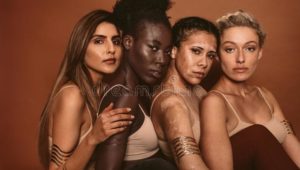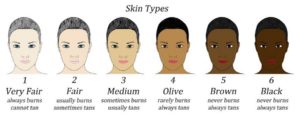
Skin structure
The skin is composed of three layers: the epidermis, the dermis, and the subcutaneous adipose tissue.
The epidermis is the outermost cuticle that we can see and touch. The epidermis is structured from many different types of cells, forming a “barrier” to protect the body from external factors such as toxins, microorganisms, fluids … Prevent invasion, harmony. between the internal and external factors of the body.
The dermis is the stratum tissue that contains fibrous structures such as collagen fibers and elastic fibers. This layer acts as the “cushion” layer, helping to support the structure of the upper epidermis layer. The dermis contains nerve elements, blood vessels should play the role of providing nutrients to nourish the epidermis. The dermis determines the level of elasticity, firmness of the skin, one of the factors that make up the color of the skin.
Subcutaneous adipose tissue is a cushion layer thicker than the dermis, acting as a load-bearing cushion, reducing damage to the skin under forces such as pressure, pressure, impact … from the external environment. . On the fatty tissue layer, there are also vascular systems that play a role in nourishing the cell system in the skin structure.
A beautiful or not beautiful skin is a combination of factors affecting these structural components, affecting the person’s perception of the skin’s beauty.

Factors that determine skin color
Genetics: Skin color is determined by the characteristics of genetic genes, thereby creating different phenotypes for each race (white skin, yellow skin, black skin …). Ingredients melanin is the deciding factor in skin color. Light or dark melanin will make the difference in skin color of groups or races in the world, from white to black skin spectrum.
Anthropological studies show that, the migrations of black races to any part of the world, people still retain their characteristic skin color after many generations, many generations; but can not change skin color like native people.
From birth, the natural color of the skin was determined through the genetic makeup, through the phenotype of the race. This color will stick and stay with that individual for a lifetime. However, skin color may be more or less influenced by internal and external factors of the body.
Sunlight: Skin color is a “spectrum” of great variation, stretching from two poles to white and black. There is a mix and arrangement of many different colors from black, brown, yellow, red, and white …
Based on how the skin reacts to the sun. Leather is classified into six different categories, according to the Fitzpatrick scale, where:
Type I-II: Common in whites, the skin contains light-colored melanin (caomelanin), the pigment granules are small, small diameter particles that are easily degenerated, resulting in light skin color. This skin type is prone to sunburn, when the skin is exposed to skin irritation, redness, blistering, peeling … but not tanned. After the irritation goes away, the skin is still white, not darkened.
Type III-V: This is a common skin type among Vietnamese people, intermediate degree of sunburn and tanning. Sometimes sunburns, but not as severe as type I-II, have a tan but not as strong as type IV.
Type V-VI: Common among people of the black race, whose skin burns almost very rarely. But under the influence of strong tan factor
Additionally, sunlight, especially UV rays, affects skin color through the body’s defense mechanisms. People who work in outdoor conditions a lot without proper protection also suffer from darker spots. The effect of UV increases the melanin production, the action of enzymes, accelerates the production of more melanin, as well as the slower melanin degradation. The melanocytes surround and form a protective coating for the nucleus of the epidermal cells, helping to limit the mutation or denaturation of these cells.
Other factors
Factors inside the body: Nutrition, health status … also have effects, making skin changes such as brighter, greener or darker than the natural color of the skin. The vascular system in the dermis also contributes to the color of the skin.
Through the ratio between the amount of oxygenated blood and the oxygenated blood in the subcutaneous vascular system, the skin will have different shades of white or white or pink. Health factors directly affect skin color, which is one of the hallmarks of a diagnosis. Such as jaundice, jaundice in liver disease; Heart disease sufferers often have bluish-white skin due to insufficient oxygen supply in the blood.
Color causes skin staining: Consuming foods high in betacarotene can cause skin to become yellow. Using many tetracyline antibiotics or in some cases the metabolites of some drugs can also affect the color of the skin, creating shades such as greenish gray, copper red … Besides, some External pigments are introduced into the skin through active (artistic) or passive (accidental) tattooing, which can cause other discoloration on the skin and on neighboring skin, due to phagocytes have “eaten” and “transported” tattoo-colored particles …
Healthy skin is really beautiful skin
Vietnamese people often prefer a fair skin because of aesthetic stereotypes and prejudices. However, white skin is not the deciding factor for beautiful or not beautiful skin.
Evaluating a beautiful skin, people often consider on many factors:
Color: Everyone has a different opinion about color. Some people like white skin, some like brown skin, and even black skin. A beautiful skin color is an even skin with no color patterns caused by damage to the skin.
Structure: Rated on the firmness, elasticity of the skin. This determines whether the skin surface is smooth or rough, the pores are small or large, the skin has more or less wrinkles. A beautiful skin must have good elasticity, small pores, smooth …
Beautiful skin is healthy, glowing skin, by many constituent factors. Skin needs comprehensive, holistic care to be truly healthy and beautiful. It is not necessary to find ways to get fair skin, which sometimes contains many unhealthy hidden features.











